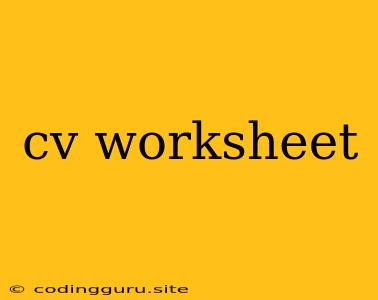Crafting the Perfect CV: A Worksheet to Guide You
A CV (Curriculum Vitae) is your professional calling card, a document that showcases your skills, experiences, and achievements. It's the first impression you make on potential employers, so it's crucial to present yourself effectively. However, creating a compelling CV can be daunting, especially if you're starting from scratch. This worksheet is designed to help you organize your thoughts and create a CV that truly highlights your strengths.
Step 1: Understanding Your Goals
- What type of job are you applying for? Be specific: What industry? What role?
- What are your career aspirations? Where do you see yourself in the next few years?
- What are your key strengths and skills? What makes you stand out from other candidates?
Step 2: Mapping Your Experiences
- Education: List your academic qualifications, starting with the most recent. Include your degree, institution, graduation date, and any relevant honors or awards.
- Work Experience: Begin with your current or most recent position, and list previous roles in chronological order. For each position, include:
- Job Title
- Employer Name
- Dates of Employment
- Key Responsibilities and Achievements Use action verbs (e.g., managed, developed, implemented, achieved) to describe your contributions. Quantify your achievements whenever possible (e.g., increased sales by 15%, reduced costs by 10%).
- Projects: Have you worked on any significant projects outside of your regular work experience? Include projects from school, volunteer work, or personal endeavors.
- Skills: List your hard and soft skills. Hard skills are technical proficiencies (e.g., programming languages, software applications, certifications), while soft skills are interpersonal abilities (e.g., communication, teamwork, problem-solving).
**Step 3: Tailoring Your CV
- Keywords: Research common keywords used in job descriptions for your target role. Incorporate these keywords throughout your CV to ensure your document is easily scanned by Applicant Tracking Systems (ATS).
- Formatting: Use a clean and professional layout. Choose a readable font and maintain consistent formatting.
- Length: Your CV should be concise and focused. Aim for one to two pages, depending on your experience level.
- Proofreading: Thoroughly proofread your CV for any errors in grammar, spelling, or punctuation. Have someone else review it as well for a fresh perspective.
Step 4: The Finishing Touches
- Cover Letter: A cover letter accompanies your CV and provides a more personalized introduction to potential employers. Tailor your cover letter to each specific job application, highlighting your relevant skills and experiences.
- Portfolio: If applicable, include a link to your online portfolio or website showcasing your work.
- References: List your references at the end of your CV. Include their names, titles, contact information, and your relationship to them. You can also choose to provide references upon request.
**Tips for Creating a Stand-Out CV
- Quantify your achievements: Instead of saying "increased sales," say "increased sales by 15%."
- Use action verbs: Start your bullet points with action verbs to make your contributions more impactful.
- Highlight your skills: Showcase your skills in a way that demonstrates their value to the employer.
- Tailor your CV to each job: Adapt your CV to align with the specific requirements of each job description.
- Get feedback: Ask a friend, family member, or career counselor to review your CV for feedback.
**Sample CV Worksheet
[Your Name] [Your Address] [Your Phone Number] [Your Email Address]
Objective: [State your career objective or the type of job you are seeking]
Education
- [Degree]
- [Institution]
- [Graduation Date]
- [Relevant Honors/Awards]
Work Experience
- [Job Title]
- [Employer Name]
- [Dates of Employment]
- [Key Responsibilities and Achievements]
- [Job Title]
- [Employer Name]
- [Dates of Employment]
- [Key Responsibilities and Achievements]
Projects
- [Project Name]
- [Description of Project]
- [Key Contributions]
Skills
- Hard Skills:
- [Skill 1]
- [Skill 2]
- [Skill 3]
- Soft Skills:
- [Skill 1]
- [Skill 2]
- [Skill 3]
References:
- [Reference Name]
- [Reference Title]
- [Contact Information]
- [Relationship to You]
Note: This is a sample CV worksheet. You may need to adjust it to fit your own unique experiences and goals.
Conclusion
Crafting a compelling CV is essential for securing your dream job. By following this worksheet, you can organize your thoughts, highlight your achievements, and create a document that effectively showcases your qualifications to potential employers. Remember to be consistent, professional, and concise in your presentation. Good luck!
